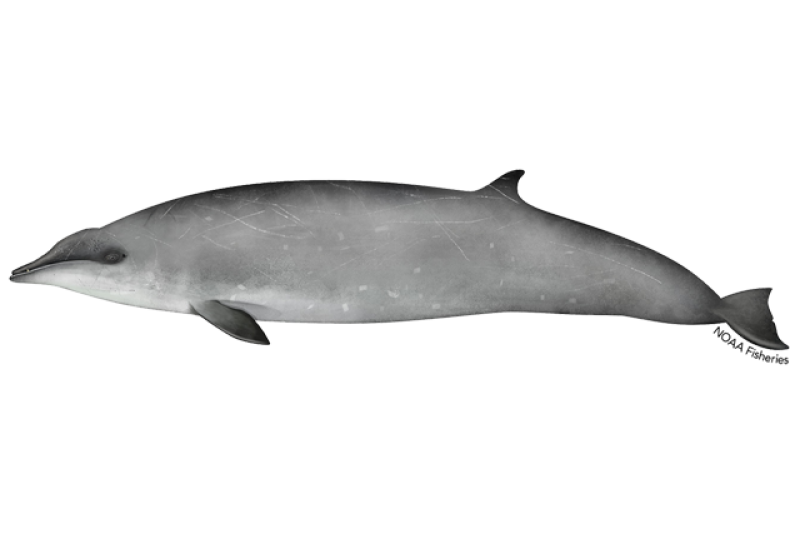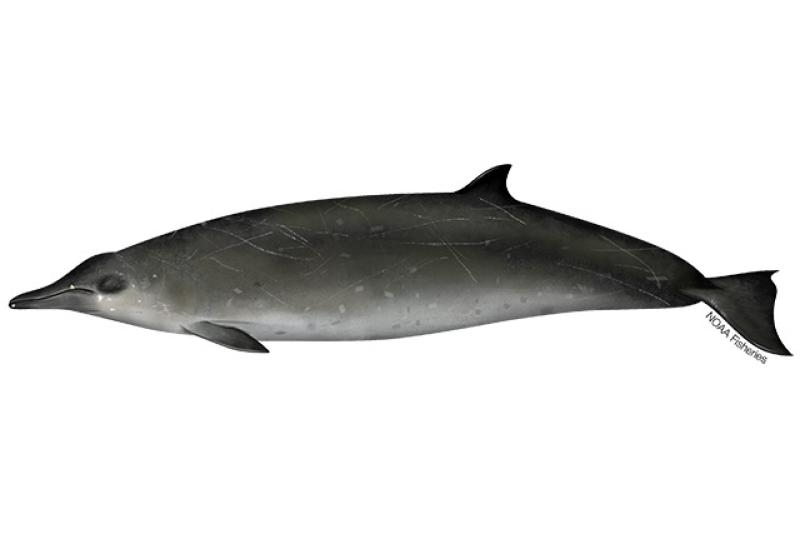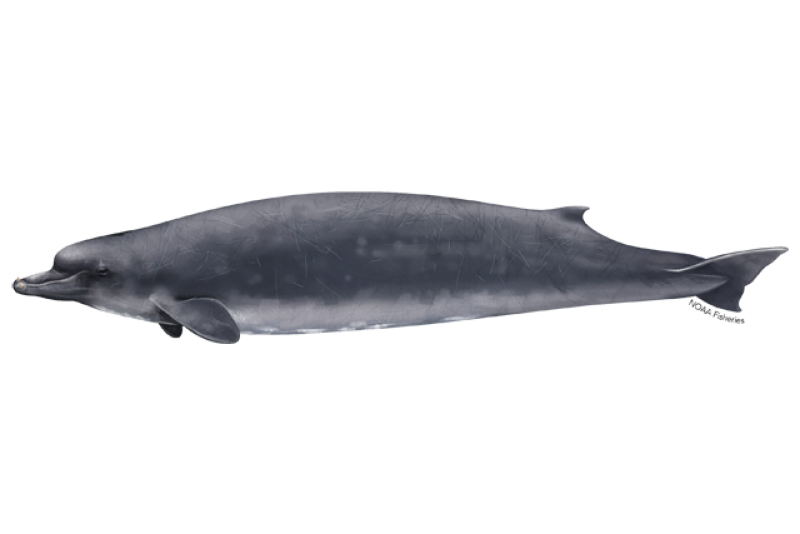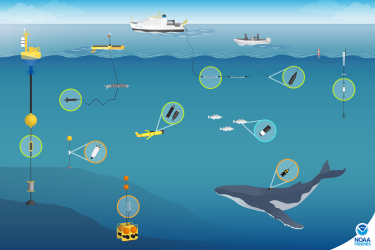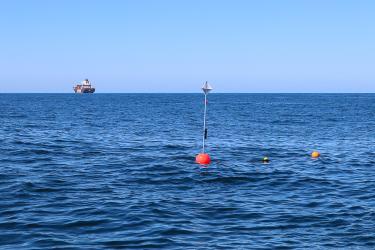Blainville's Beaked Whale
Mesoplodon densirostris
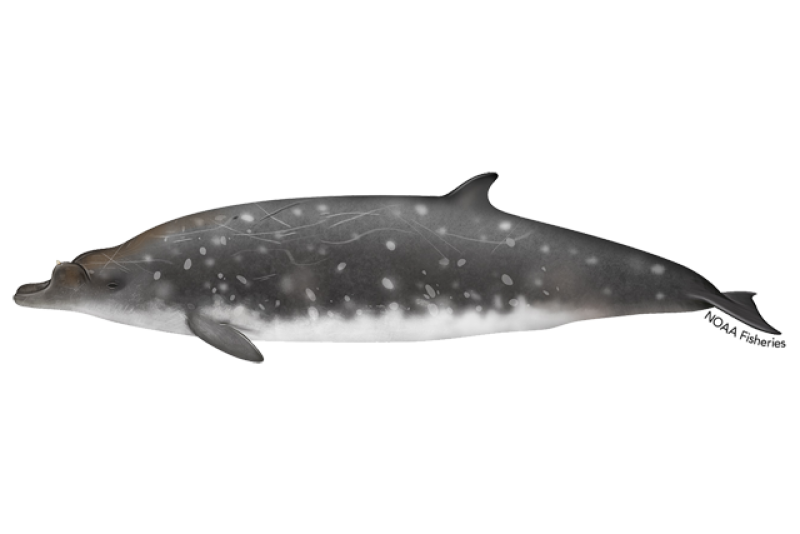
Protected Status
Quick Facts
 Head of a solitary adult male Blainville’s beaked whale showing the high bottom jaw line and the erupted teeth. Credit: NOAA Fisheries
Head of a solitary adult male Blainville’s beaked whale showing the high bottom jaw line and the erupted teeth. Credit: NOAA Fisheries
Head of a solitary adult male Blainville’s beaked whale showing the high bottom jaw line and the erupted teeth. Credit: NOAA Fisheries
About the Species
 Head of a solitary adult male Blainville’s beaked whale showing the high bottom jaw line and the erupted teeth. Credit: NOAA Fisheries
Head of a solitary adult male Blainville’s beaked whale showing the high bottom jaw line and the erupted teeth. Credit: NOAA Fisheries
Head of a solitary adult male Blainville’s beaked whale showing the high bottom jaw line and the erupted teeth. Credit: NOAA Fisheries
Blainville's beaked whales are little-known members of the beaked whale family, Ziphiidae. Sometimes known as the "dense-beaked whale," this species lives in tropical to temperate waters worldwide. It is typically found in deep, offshore waters (656 to 3,281 feet) off the continental shelf and often associated with steep underwater geological structures, such as banks, submarine canyons, seamounts, and continental slopes.
There is little information on the abundance of Blainville’s beaked whales worldwide, though they are considered to have the most extensive distribution of any whale in the Mesoplodon genus. The beaked whale family is cryptic and evasive, and distinguishing between species in the field can be challenging.
Like all marine mammals, Blainville’s beaked whales are protected under the Marine Mammal Protection Act. They face threats from entanglement in fishing gear, ingestion of marine debris, and human-caused noise.
Population Status
NOAA Fisheries estimates population size for each stock of Blainville’s beaked whale in its stock assessment reports. A stock is a group of animals that occupy the same area and interbreed. There are insufficient data to determine the population trends for this species.
For management purposes, Blainville's beaked whales inhabiting U.S. waters have been divided into three stocks:
- Hawaiian
- Northern Gulf of America* (formerly Gulf of Mexico)
- Western North Atlantic
The northern Gulf of America and western North Atlantic stocks are considered "strategic" because of uncertainty regarding their population size and evidence of fishery-related mortality and serious injury.
Appearance
As adults, Blainville's beaked whales can reach lengths of approximately 15 to 20 feet and weigh 1,800 to 2,300 pounds. Mature males can be easily distinguished from females and juveniles by a pair of large, visible, tusk-like teeth that erupt and point forward from their heavily arched lower jaw. These tusk-like teeth are sometimes covered with barnacles. Females and juveniles also have teeth, but they remain hidden beneath the gum tissue of the mouth, and their jawline is less curved.
Blainville's beaked whales have a medium-sized, round body with a small, wide-based, slightly hooked dorsal fin located far down the animal's back. They also have a low, sloping, indistinct forehead (or melon). Their coloration varies from dark-gray to brownish and bluish. The animal’s face and underside are pale gray or white, giving it a countershading appearance. The skin may appear wrinkled on the dorsal area and is covered with linear and oval-shaped scars and other markings. Individuals, especially mature males, accumulate scars and scratches with age. Diatom (microscopic planktonic algae) infestation may discolor areas of the skin.
Behavior and Diet
Blainville's beaked whales are usually found individually or in small social groups averaging between three and seven animals, but they have been occasionally seen in larger groups of up to 12 animals. Groups may consist of various combinations of age and sex and/or be segregated depending on age or sex. Adult populations in productive waters over the continental shelf (e.g., the Bahamas) may be grouped in harems that consist of several adult females with a single adult mature male. Males commonly battle over access to females, which is probably the cause of the long, linear scars seen on individuals.
Like other beaked whales, Blainville’s beaked whales are deep divers. Regular dives range from 20 to 45 minutes and commonly reach depths of at least 1,600 to 3,300 feet, but dives of over 54 minutes and up to 4,600 feet have also been recorded. While diving, they use suction to feed on small fish and cephalopods (e.g., squid) in deep water.
Lifespan & Reproduction
The estimated lifespan of Blainville's beaked whales is unknown. They may reach sexual maturity at about 9 years of age. A sexually mature female will give birth to a single newborn calf that is about 6 to 8.5 feet long and weighs about 130 pounds.
Threats
Entanglement in Fishing Gear
Unidentified beaked whales (which may include Blainville's beaked whales) have been entangled or captured in the pelagic drift gillnet fishery off the U.S. Atlantic coast. Japanese fishing boats in the Indian Ocean (off of Seychelles and western Australia) have also incidentally taken Blainville's beaked whales, and they have been occasionally caught as bycatch in hunts targeting small cetaceans.
Marine Debris
Some beaked whales have died from ingestion of marine debris.
Ocean Noise
Deep-diving cetaceans, like Blainville’s beaked whales, use sound to feed, communicate, and navigate in the ocean. Recently, strandings of this species in the Bahamas because of acoustic trauma have been associated with use of active sonar during naval military activities and exercises. Sound pollution threatens Blainville’s beaked whales by interrupting their normal behavior and driving them away from areas important to their survival, such as breeding and feeding waters.
*Executive Order 14172, “Restoring Names That Honor American Greatness” (Jan. 20, 2025), directs that the Gulf of Mexico be renamed the Gulf of America. Gulf of America references in this website refer to the same area as the Gulf of Mexico in the applicable regulations under 50 CFR parts 216–219, 222–226, and 600–699. The name change did not result in any changes to, and had no effect on the applicability or enforceability of, any existing regulations. This website continues to use “Gulf of Mexico” when quoting statutes, existing regulations, or previously published materials.
Scientific Classification
| Kingdom | Animalia | Phylum | Chordata | Class | Mammalia | Order | Cetacea | Family | Ziphiidae | Genus | Mesoplodon | Species | densirostris |
|---|
Last updated by NOAA Fisheries on 04/24/2025
What We Do
Conservation & Management
All Blainville’s beaked whales are protected under the Marine Mammal Protection Act. Our work protects this species by:
- Reducing interactions with commercial and recreational fishing gear
- Issuing take reduction plans
- Implementing requirements to reduce serious injuries and mortalities
- Minimizing the effects of vessel disturbance, noise, and other types of human effects
Science
Our research projects have helped us better understand Blainville’s beaked whales and the challenges they face. Our work includes:
- Stock assessments
- Acoustic monitoring
- Satellite tagging and tracking
- Photo-identification
How You Can Help
Keep Your Distance
Be responsible when viewing marine life in the wild. Observe all large whales from a safe distance of at least 100 yards and limit your time spent observing to 30 minutes or less.
Report Marine Life in Distress
Report a sick, injured, entangled, stranded, or dead animal to make sure professional responders and scientists know about it and can take appropriate action. Numerous organizations around the country are trained and ready to respond. Never approach or try to save an injured or entangled animal yourself—it can be dangerous to both the animal and you.
Learn who you should contact when you encounter a stranded or injured marine animal
Report a Violation
Call the NOAA Fisheries Enforcement Hotline at (800) 853-1964 to report a federal marine resource violation. This hotline is available 24 hours a day, 7 days a week for anyone in the United States.
You may also contact your closest NOAA Office of Law Enforcement field office during regular business hours.
Featured News

 Rice's Whale. Credit: NOAA Fisheries
Rice's Whale. Credit: NOAA Fisheries
Protecting Species While Planning for Offshore Wind Development in the U.S. Gulf of Mexico
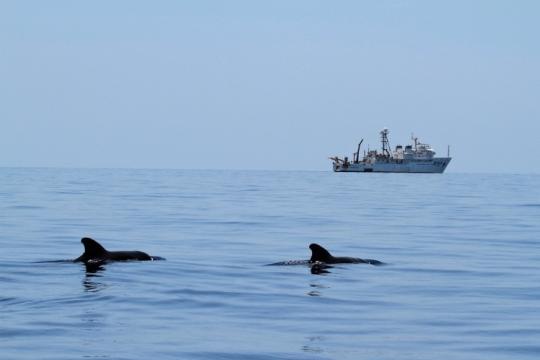 Pilot whales surface near the NOAA Ship Gordon Gunter. Credit: NOAA Fisheries/Melody Baran (Permit # 14450)
Pilot whales surface near the NOAA Ship Gordon Gunter. Credit: NOAA Fisheries/Melody Baran (Permit # 14450)
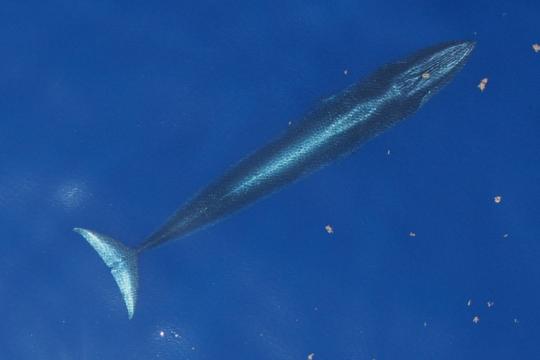 A Rice’s whale just under the surface of the water in the Gulf of Mexico. This endangered whale was recognized as a separate species from the Bryde’s whale in 2021. Credit: NOAA Fisheries under NOAA Permit No. 21938.
A Rice’s whale just under the surface of the water in the Gulf of Mexico. This endangered whale was recognized as a separate species from the Bryde’s whale in 2021. Credit: NOAA Fisheries under NOAA Permit No. 21938.
Celebrate Whale Week with Us: A Message from Janet Coit, Assistant Administrator of NOAA Fisheries
Management Overview
The Blainville's beaked whale is protected throughout its range under the Marine Mammal Protection Act.
Additionally, the Blainville's beaked whale is listed under:
- Appendix II of the Convention on International Trade in Endangered Species of Wild Fauna and Flora (CITES)
- Annex II of the Protocol for Specially Protected Areas and Wildlife (SPAW)

Conservation Efforts
Reducing Interactions with Fishing Gear
Blainville’s beaked whales have been are caught as bycatch in fishing gear, leading to deaths and serious injuries. To reduce bycatch, NOAA Fisheries requires the use of acoustic pingers and 6-fathom net extenders in the California/Oregon drift gillnet fishery as part of the Pacific Offshore Cetacean Take Reduction Plan.
Learn more about bycatch and fisheries interactions
Overseeing Marine Mammal Health and Stranding Response
We work with volunteer networks in all coastal states to respond to marine mammal strandings including all whales. When stranded animals are found alive, NOAA Fisheries and our partners assess the animal’s health and determine the best course of action. When stranded animals are found dead, our scientists work to understand and investigate the cause of death. Although the cause often remains unknown, scientists can sometimes attribute strandings to disease, harmful algal blooms, vessel strikes, fishing gear entanglements, pollution exposure, and underwater noise. Some strandings can serve as indicators of ocean health, giving insight into larger environmental issues that may also have implications for human health and welfare.
Learn more about the Marine Mammal Health and Stranding Response Program
Marine Mammal Unusual Mortality Events
Blainville’s beaked whales have been part of a declared unusual mortality event in the past. Under the Marine Mammal Protection Act, an unusual mortality event is defined as "a stranding that is unexpected; involves a significant die-off of any marine mammal population; and demands immediate response." To understand the health of marine mammal populations, scientists study unusual mortality events.
Get information on active and past UMEs
Get an overview of marine mammal UMEs
Addressing Ocean Noise
NOAA Fisheries is investigating all aspects of acoustic communication and hearing in marine animals, as well as the effects of sound on beaked whale behavior and hearing. For example, the use of some types of shipboard echosounders decreases the acoustic detection rates of multiple species of beaked whales, indicating that they change their behavior when they hear these echosounders. In 2016, we issued technical guidance for assessing the effects of anthropogenic sound on marine mammal hearing.
Regulatory History
Like all marine mammals, Blainville’s beaked whales are protected under the MMPA.
In 1997, NOAA Fisheries implemented the Pacific Offshore Cetacean Take Reduction Plan, which requires the use of acoustic pingers and 6-fathom net extenders in the California/Oregon drift gillnet fishery to reduce bycatch of cetaceans, including Blainville’s beaked whales. The Pacific Offshore Cetacean Take Reduction Team continues to meet and recommend measures to further reduce bycatch and achieve MMPA goals.
Key Actions and Documents
Last updated by NOAA Fisheries on 04/24/2025
Science Overview
NOAA Fisheries conducts a variety of research on the biology, behavior, and ecology of Blainville’s beaked whales. The results of this research are used to inform management decisions and enhance protection efforts for this species.

Stock Assessments
Determining the size of Blainville’s beaked whale populations helps resource managers gauge the success of NOAA Fisheries’ conservation measures. Our scientists collect and present these data in annual stock assessment reports.
Shipboard Studies
NOAA Fisheries conducts research cruises to collect information on beaked whale stocks, such as habit preferences and feeding ecology. For example, we have estimated the abundance of the three Blainville’s beaked whale stocks and other cetaceans, using oceanic research vessels to perform line-transect surveys. Information from this research can be used in management actions to protect these animals.
Acoustic Science
Our research is also focused on acoustics—using underwater sound to learn more about this species. We study the basic acoustic behavior of cetaceans and fish, mapping the acoustic environment and finding better ways to study cetaceans using passive acoustic technologies. Because Blainville’s beaked whales are difficult to detect visually, and because they dive for extended periods of time, passive acoustic detection is important in studying this, and all, beaked whale species. For example, hydrophone arrays can be towed behind ships to acoustically detect and locate Blainville’s beaked whales during surveys, and archival bottom-mounted recorders are used to monitor long-term occurrence of the species at specific recording sites.
Our acoustic research also assesses the degree to which human-caused activities are changing the underwater soundscape, how these changes may potentially impact marine animals, and what measures can be taken to mitigate these potential impacts.
More Information
Recent Science Blogs
Last updated by NOAA Fisheries on 04/24/2025
Data & Maps
Passive Acoustic Cetacean Map
This mapping tool shows when and where specific whale, dolphin, and other cetacean species were…
Research
Killer Whale and Beaked Whale Posters
Art-Science Collaboration Celebrates the Diversity of Killer Whales and Beaked Whales from Around the World
Geographic Differences in Blainville’s Beaked Whale (Mesoplodon densirostris) Echolocation Clicks
We use acoustic recordings collected over broad time and space scales to investigate whether global…
Last updated by NOAA Fisheries on 04/24/2025
